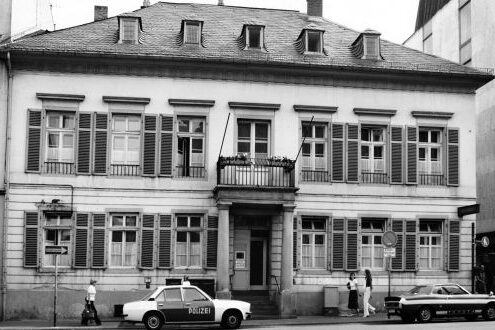Schenck's house
The "Schenck'sche Haus" in Friedrichstraße, which housed a police station for decades, is one of the oldest houses in Wiesbaden. It was renovated in 2012 and is now home to various institutions.
The so-called Schenck'sche Haus at Friedrichstraße 32 is one of the oldest in Wiesbaden's city center and was planned and built between 1813 and 1817. The plans are often attributed to the architect Christian Zais; according to a statement made by Helfrich Bernhard Hundeshagen in December 1815, the representative design of the portico in particular was probably the work of Zais.
The involuntary client was initially the pharmacist Carl Philipp Otto, who in March 1813 was granted the privilege of running a pharmacy by Duke Friedrich August only on the condition that he build a stately home in the newly developed Friedrichstraße. However, Otto ran into financial difficulties and so the court bookseller and printer Ernst Ludwig Theodor Schellenberg took over the building site and the plans from the bankruptcy estate in 1815. But even he did not succeed in completing the building. After struggling with the craftsmen for a good year and spending 11,300 guilders, he handed over the shell of the building in 1816 in exchange for the inn "Zur Stadt Darmstadt" to the Privy Councillor Friedrich Carl Schenck, after whom the house was named.
The elegant two-storey building with seven axes and a narrow columned portico emphasizing the middle shows stylistic tendencies of classicism in harmonious proportions. The western corner of the building is free-standing, while the eastern side was originally only connected to the neighboring house by an archway that was later built over.
Its use was as varied as the building's history. Schenck owned the house until 1835, when it was purchased on behalf of Duke Wilhelm in connection with the planned construction of a city palace between Luisenstrasse and Friedrichstrasse. From 1845, the house housed the ducal tax office, from 1864, after the construction of the courtyard building in 1860, the police headquarters, a Prussian office during the Weimar Republic and, from 1937 to 2009, a police station again. After the latter moved out and the building was acquired by the city of Wiesbaden, it was renovated in 2012. In future, the state foundation "Miteinander in Hessen", the office of the goEast film festival, the Wiesbaden Seniors' Advisory Council, the "Leben und Wohnen im Alter" advice center of GWW Wiesbadener Wohnbaugesellschaft mbH, the Büro für Staatsbürgerliche Frauenarbeit e.V. and the MigraMundi e.V. association will be based here.
Literature
- Struck, Wolf-Heino
Wiesbaden in the Age of Goethe, Wiesbaden 1979 (p. 125 f.).
- Kiesow, Gottfried
The misjudged century. The example of historicism in Wiesbaden, Bonn 2005 (p. 122).
- Müller-Schellenberg, Guntram
A gem of the city's history. In: Wiesbadener Kurier from 17.1.2007.
- Noack, Erika
Wiesbaden street stories. The Friedrichstraße, Wiesbaden 2012 (pp. 72-74).
